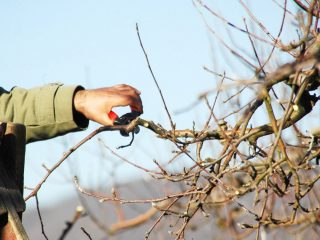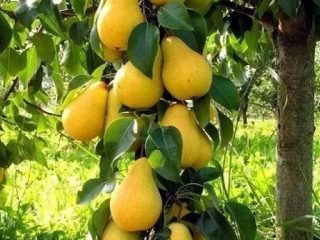Content
- 1 Climatic features of the region
- 2 Early pear varieties for central Russia
- 3 Mid-season pear varieties
- 4 Late pear varieties for central Russia
- 5 Sweet pear varieties for central Russia
- 6 Low-growing varieties of pears for the middle zone
- 7 Columnar varieties of pears for the middle zone
- 8 Self-fertile pear varieties for the middle zone
- 9 New varieties of pears for central Russia
- 10 Conclusion
- 11 Reviews of pear varieties for central Russia
The description of pear varieties for central Russia allows you to choose a productive, hardy and unpretentious variety of fruit crop. Before purchasing a seedling, you should study popular options and reviews about them.
Climatic features of the region
Central Russia is characterized by a continental climate with warm summers and moderate rainfall. Winters in the region are quite long, but not too cold and snowy. Spring comes late and is often accompanied by night frosts.Autumn usually arrives in early October and is characterized by prolonged rains.
When choosing a pear for the middle zone, you should give preference to frost-resistant species with strong immunity. The tree must be resistant to scab, powdery mildew and other common ailments that develop against a background of dampness.
Early pear varieties for central Russia
When planting an early pear, you can harvest it as early as July. Several varieties have a large number of positive reviews.
Prominent
A winter-hardy pear variety for the middle zone grows up to 6 m above the ground. It has a pyramidal narrow crown and bears fruits weighing up to 170 g. One tree can produce up to 50 kg of fruit during the summer.
The species is valued by gardeners for its self-fertility; it can be grown on the site without pollinators. Pear trees rarely suffer from powdery mildew and scab, and are not affected by pests with minimal care. The harvest has a pleasant taste, the fruits are approximately the same in size and have a neat, regular shape.

Vidnaya pear is stored in a warm place for up to one and a half weeks
Bryansk beauty
The winter pear has a rounded crown, grows slowly, and is not prone to thickening. The fruits of the variety are slightly oblong with a pronounced thickening in the lower part, reaching a weight of 200 g. The color is golden, on one side there may be a dark reddish-brown blush.
Bryansk beauty has a delicate sweet taste of pulp and a pleasant aroma. It begins to bear fruit in the fifth year and does not require pollinators. When grown, it rarely suffers from scab even in damp summers.

The frost resistance index of the Bryansk beauty species is -38 °C
Same age
The low pear grows up to 3 m, has a compact crown and is well suited for small areas. It enters the fruiting period from the third season, producing round-shaped fruits weighing up to 130 g.
The color of the pear is yellow with an orange tint, the flesh is sour-sweet. The species has a stable yield and tolerates frosts in the middle zone down to -35 °C.

The fruits of the Rovesnitsa variety acquire the most intense taste a week after harvest.
Banana
The tall pear has curved shoots that form a drooping crown. Reaches 6 m above the ground, requires regular pruning to avoid thickening. The advantages of the variety include high yield and good frost resistance. In addition, the tree is rarely affected by scab and garden pests.
Pear fruits are compact, up to 80 g, covered with greenish skin. Reddish tan spots are visible on the surface. The harvest ripens in early August and can be stored for 2.5 months.

Banana pear has a dessert taste, which tasters rate at 4.6 points.
Skorospelka from Michurinsk
The medium-sized tree reaches 4 m above the ground and has a pyramidal, slightly thickened crown. It spreads widely in diameter, grows quickly, and begins to bear fruit from the fifth year of life. The fruits are small, round, up to 70 g in total, yellow in color with a pinkish blush.
The pulp has a pleasant taste. But most often Michurinskaya Skorospelka is not consumed fresh, but is sent for processing - this is due to its small size.

Skorospelka Michurinskaya calmly tolerates cold, wet summers and does not suffer from scab
Mid-season pear varieties
Among the popular varieties of pears for central Russia there are many species that ripen in August. The fruits not only have a pleasant taste, but are also suitable for long-term storage.
Veles
The fruits of the variety are greenish-yellow with an orange tan. The pulp is sweet and tender, quite juicy. With industrial cultivation of the variety, up to 130 centners of crop can be harvested from 1 hectare of land.

The weight of fruits of the Veles variety in the middle zone is about 120 g
Thumbelina
A tasty pear variety for the middle zone bears compact, elongated yellow fruit with a slight blush. The weight of the fruit is about 70 g. In winter, the variety can withstand cold temperatures down to -38 ° C, and in summer it tolerates both periods of drought and prolonged rains.

When growing Thumbelina, you need to harvest the crop on time, as it is prone to shedding.
Simply Maria
The early-growing species begins to produce crops three years after planting. Shows high fruiting rates. With minimal insulation, it can withstand significant temperature drops.
The fruits of the variety are large, up to 180 g. The taste is very pleasant, sweet, the variety belongs to the dessert category.

It’s just that Maria can freeze slightly in cold winters, but with the onset of spring she quickly recovers
Irista
A popular variety for the middle zone brings abundant harvests. The fruits have the correct shape. Within a week of storage, they turn from greenish to yellow. The Irista variety has a sweet taste; light sour notes are noticeable in the pulp.

The fruit weight of the Irista variety is about 160 g
Yeseninskaya
The medium-sized pyramidal variety of pear is valued for its early fruiting and unpretentiousness. The crop enters the period of productivity from the second year of life.
The fruits on the shoots appear smooth, conical in shape with a wide base, light green in color with reddish spots. The pulp has good juiciness and nutmeg taste.

One adult Yeseninskaya pear can produce up to 40 kg of harvest
Late pear varieties for central Russia
Late pears ripen towards mid or late autumn. Such varieties are valued for their long shelf life - the harvest often lies in the refrigerator until spring.
Belarusian late
A late-autumn pear variety for the middle zone, it has a sweet and sour refreshing taste. The fruits on the branches appear wide, weighing up to 120 g, with oily and juicy pulp. The skin of the fruit is light orange with a raspberry tan.

Belorussian late is partially self-fertile, forms ovaries without pollinators, but in small quantities
Miraculous
The dwarf pear variety for the middle zone has a thick crown and tolerates frost well. It has high immunity and is not affected by fungi and copperhead. Ripens in early autumn, produces large fruits, up to 300 g, with sweet and sour pulp and pinkish skin with blush.

Wonderful pear can be stored for up to 3.5 months and tolerates transportation well
January
A winter-hardy pear variety for the middle zone has been known since the 1970s. It bears fruits of a greenish color with a bright blush. The pulp of the variety is white, with a slight light green tint. After ripening, it acquires good juiciness and a sweet dessert taste.

January pear reaches 150 g in weight
Pear trees need to be harvested in mid-September.It is important to remove the fruit from the branches in time, otherwise they may harden. After harvesting, the crop is stored for 2-3 weeks, and after yellowing it is eaten.
Extravaganza
A pear tree up to 2 m tall with a wide pyramidal crown does not cause major problems when caring. The fruits are elongated, yellow when ripe, up to 140 g in weight. The skin is dense, the flesh is juicy and quite tender, with a sweet taste.
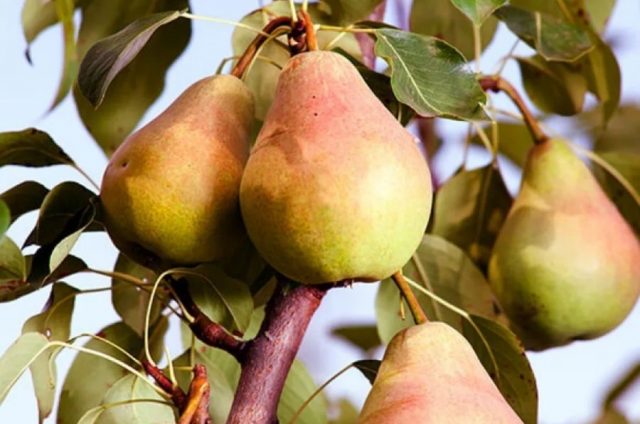
When growing the Extravaganza variety, you need to pay attention to pruning, otherwise the fruits will begin to shrink.
Novella
The variety demonstrates high resistance to scab and other fungal diseases. It grows to about 4 m in the middle zone, and can spread up to 3 m in diameter.

The Novella variety does not require pollinators
Forms fairly large fruits of a greenish color with a pink tan. The pulp is granular, but juicy, with a pronounced aroma. Fruits can be stored for up to five months after picking.
Sweet pear varieties for central Russia
Sweet varieties are traditionally the most popular. They are consumed fresh immediately after collection or processed to make compote and jam.
Yuryevskaya
The variety ripens by early October. The fruits in the middle zone are green-yellow with a slight brownish tan, with dense juicy pulp. The sweet taste has light and pleasant sour notes.

The tasting score of the Yuryevskaya variety is 4.5 points
Kokinskaya
The mid-season variety bears fruit from the end of August; fruit can be collected until mid-September.The variety is not afraid of fungi and pests and can withstand wet and dry weather well.

The Kokinskaya variety reaches peak yield by the 6-7 season after planting
Pears are drop-shaped, with an average weight of 160 g. The greenish-yellow thin skin shows pink or orange blush spots that appear under the influence of the sun. The fruit tastes sweet, slightly spicy.
Elegant Efimova
The hybrid variety ripens in September and forms elongated fruits weighing up to 180 g. The skin is smooth with a waxy sheen, yellowish-green in color with a crimson tinge. Inside, the pear is sweet and soft, with a delicate aroma and light tart notes.

Elegant Efimova is stored for about two weeks at a temperature below 10 ° C
Low-growing varieties of pears for the middle zone
Low-growing pear varieties usually have low yields. However, it is easier to care for such trees, and in the middle zone they are easy to insulate for the winter.
Treasure
The high-yielding table variety grows to a maximum height of 2.2 m. The crown of the tree is pyramidal, moderately thick. The fruits are large, wide-conical, light yellow with rusty spots. The skin is quite thick, the flesh is oily and tender, sugary with a slight sourness. The average fruit weight is 250 g.

The Treasure variety should be harvested from the beginning of September.
Sverdlovsk resident
The young variety first appeared on the horticultural market in 2011. It quickly gained popularity due to its high yield and pleasant taste with sourness. The pear variety for the middle zone is early-bearing, producing fruit in early August. The harvest begins for the first time 3-4 years after planting the tree on the site.

The shelf life of Sverdlovchanka is about three months
August dew
A low-growing summer variety for table use, it bears fruits with sour-sweet pulp. Pears are quite large, up to 200 g, covered with a thin yellowish skin, and have a blush on the sides. This variety can be harvested in the last days of summer or early September.
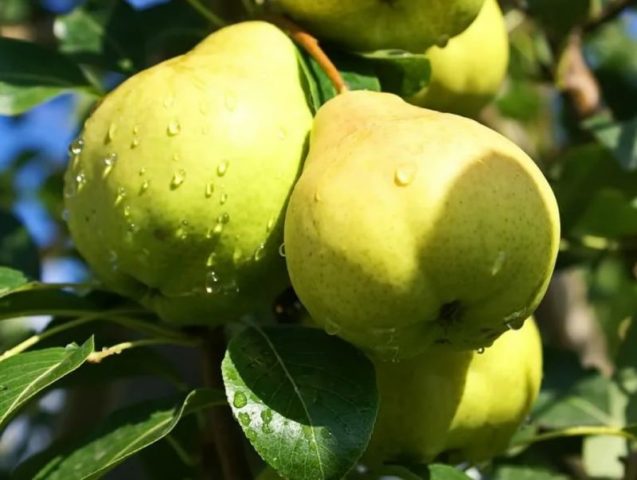
The August Dew variety begins to form ovaries in the third year of life.
Columnar varieties of pears for the middle zone
Columnar pears are distinguished by their compact outline and short stature. The trees are easy to care for and harvesting the fruits takes little time.
Muscovite
The columnar pear variety for the middle zone calmly tolerates rainy and cold weather and does not suffer from rot and scab. Forms fruits up to 140 g in weight with high juiciness, the peel of the fruit is greenish-yellow with a pink tan.

Muscovite produces a crop only if there are pollinators nearby
Pass Krassan
The variety bears sweet and juicy fruits, usually reaching 180 g in weight. The fruits have a slight sourness and emit a rich aroma. The variety tolerates drought well, but if there is a lack of moisture, the fruits can acquire tart notes.

Pass Krassan bears fruit in October, the taste of the harvest is fully revealed after three months
Sapphira
The autumn pear ripens by the beginning of September in the middle zone. It is resistant to frost, valued for the pleasant taste of the fruits and their large size. The fruit is greenish in color and slightly browned.

The first fruiting of the Sapphire pear occurs in the third year after planting
Self-fertile pear varieties for the middle zone
Self-pollinating varieties of pears for the middle zone are convenient to grow in small areas where it is impossible to plant a large number of trees. Such varieties produce abundant harvests in cold summers because they do not depend on pollinators.
Olivier de Serres
A medium-sized variety with a round, slightly flattened crown produces fruits weighing up to 150 g in weight. The skin is dense, green with brown dots and spots, slightly bumpy. Sometimes a faint blush is visible on the surface. The pulp is sweet with almond notes.

The fruits of Olivier de Serre do not fall off after ripening
In memory of Yakovlev
The species is characterized by rapid growth, reaching only 2.5 m above the ground. It bears smooth, slightly ribbed fruits up to 150 g, and produces its first crop in the third year. It forms ovaries both with and without the participation of pollinators, and demonstrates high resistance to septoria and scab.

In memory of Yakovlev withstands frosts down to -37 ° C
Children's
The pear variety reaches 3 m above the ground and brings up to 20 kg of yield per plant. Forms small light yellow fruits up to 80 g in weight, covered with a pinkish tan. Ripening begins at the end of July.
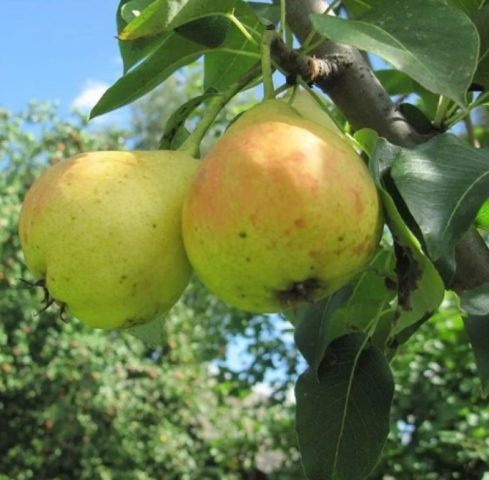
Children's pear can be stored in a cool place for a month
New varieties of pears for central Russia
Since pears are in demand in the middle zone, breeders regularly develop new varieties. Some of the young varieties have managed to gain great popularity.
Allegro
The medium-sized variety is characterized by rapid growth. A modern pear variety for central Russia bears fruits with a delicate, smooth, greenish skin with an outer blush. The appearance is sweet, juicy, without astringency.

Allegro pear demonstrates high resistance to temperature changes
Annushka
The autumn variety produces oval or pear-shaped fruits that acquire a golden color after picking. It is distinguished by its juiciness and dessert taste; the harvests are quite abundant.

The fruit weight of the Annushka variety is about 140 g
Hera
The variety bears fruit in mid-September. Pears can be stored for up to five months at low temperatures. The variety is valued by gardeners for its frost resistance and high immunity to infections.

The pear variety Gera deserves a tasting score of 4.3 points
Conclusion
The description of pear varieties for central Russia includes tall and short types of early and late ripening. When choosing, you need to focus on the volume of fruiting and reviews of taste.
Reviews of pear varieties for central Russia



